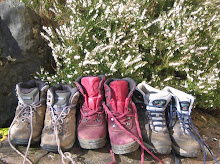The problem (if there can be one) with living on such a rich island is that biodiversity means everything to some but, unfortunately, nothing to many!
 Approachable Without Menace
Approachable Without MenaceAmong the most welcome of insects, this Hoverfly (Episyrphus balteatus) is nectaring on a St. John’s Wort flower. They are beautiful and harmless, flapping their wings several hundred times per second just to remain stationary in the air, the insect world’s equivalent of a Kestrel. Despite the fact that they are stingless, hoverflies choose to mimic bees and wasps in their colouration to avoid predation – 09/09/11
 Luscious and Inviting?
Luscious and Inviting?The main driveway into the centre of Aros Park in Tobermory is bedecked with the dark fruits of the leafy shrub Gaultheria shallon. Initially planted as cover for Pheasants and other game birds in the heyday of the shooting estate in the 19th Century, these shrubs now form dense thickets of growth, often to the detriment of other plants. Uniquely flavoured, the berries are edible and have been used as an appetite suppressant in the past. We suspect that the uniqueness of the flavour tells you all you need to know regarding their taste! – 04/09/11
 Lunar Lichen
Lunar LichenEncrusted on the trunks of many of the island’s majestic oaks is a remarkable organism that is part algae and part fungus. The Cudbear lichen enjoys a symbiotic relationship that ensures its survival among a myriad of other lichens and mosses on Mull’s grandest trees. Look closely and the pale margins of the caramel-tinted reproductive discs take on a new life, as the rims of meteor-blasted craters on a lunar landscape. Perhaps it was here that Apollo 11 made good the first moon landing all those years ago, stoking the fires of conspiracy as it did? – 19/03/11
 Consistent and Dependable
Consistent and DependableThe Isle of Mull is currently enjoying its best-ever year for birds, based on the large number of unusual sightings that have been reported. Yet, ‘best-ever’ and ‘unusual’ are relative terms and should never take away from the common-place and everyday enjoyment and fascination that we derive from the frequent and usual birdlife that lives on the island. We know of so many people who forego the pleasures of what’s on their doorstep to chase after something deemed more interesting and exciting. At Mull Magic, the Meadow Pipit is the new White-tailed Eagle and the Robin is the Roller! – 10/04/11
 The Bay Bolete epitomises the way that Mull’s landscapes and wildlife bombard your senses: it looks simply amazing, it has a wonderfully spongy texture, smells pleasant and tastes good into the bargain! When bruised or exposed to the air, this incredibly eye-catching toadstool stains blue, while the reticulated red-brown stem is yellow at its apex, just like the colour of its pores. An altogether super-colourful treat that we spotted on a recent foray through a woodland in North Mull – 15/09/11
The Bay Bolete epitomises the way that Mull’s landscapes and wildlife bombard your senses: it looks simply amazing, it has a wonderfully spongy texture, smells pleasant and tastes good into the bargain! When bruised or exposed to the air, this incredibly eye-catching toadstool stains blue, while the reticulated red-brown stem is yellow at its apex, just like the colour of its pores. An altogether super-colourful treat that we spotted on a recent foray through a woodland in North Mull – 15/09/11


















